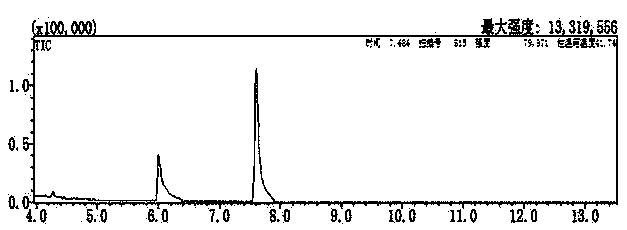Method of detecting bromonitromethane content in drinking water by GC/MS combination
A technology for bromonitromethane and drinking water is applied in the field of bromonitromethane content, which can solve problems such as health hazards, and achieve the effects of saving water samples and high sample cost.
- Summary
- Abstract
- Description
- Claims
- Application Information
AI Technical Summary
Problems solved by technology
Method used
Image
Examples
Embodiment 1
[0029] Embodiment 1: terminator selection
[0030] Usually the residual chlorine in drinking water after disinfection is between 0.05 ~ 4.0mg / L, and there will be a relatively high content of residual chlorine in the test water samples generated by DBPs, and it is necessary to add a reducing terminator to eliminate the strong Oxidative residual chlorine terminates the chlorination reaction process. In order to avoid the impact of the terminator on the stability of BNM as much as possible. The effect of commonly used terminators on the stability of BNM needs to be investigated.
[0031] Use pure water to prepare multiple water samples of BNM with a concentration of 100 μg / L, select one of the water samples to measure the peak area M immediately by the gas phase / mass spectrometer in the full scan (SCAN) mode, in addition, separately to other BNM Add the terminator (ascorbic acid, sodium thiosulfate, sodium sulfite, ammonium chloride) to the water sample to make the concentrati...
Embodiment 2
[0032] Embodiment 2: the selection of extractant
[0033]First pass the water sample through a 0.22 μm microporous membrane, then add 8 g of anhydrous sodium sulfate to a glass bottle containing 25 mL of water sample, place it on an oscillator at a speed of 720 r / min, and oscillate until the salt is completely dissolved, and the solution It is transparent, and the liquid level rises slightly; after that, add 2mL of extractant, place it on a shaker at a speed of 720r / min, oscillate for 5min, remove the sample bottle, let it stand for 5min, take the upper layer of extractant, and perform GC / MS analysis. Determination. In this experiment, two kinds of extractants (methyl tert-butyl ether and ethyl acetate) were used, and the extraction effects of the two were compared, that is, the one with higher recovery rate was superior. The extraction recovery rate of methyl tert-butyl ether (MTBE) to BNM is 92.5%-106.2%, while the recovery rate of ethyl acetate (ETAC) is 82.5%-104.2%. The...
Embodiment 3
[0034] Embodiment 3: the selection of internal standard substance
[0035] In the present invention, 1,2-dibromopropane and n-decane were used as internal standard substances for comparative study, which were dissolved in methyl tert-butyl ether and prepared step by step to a concentration of 150 μg / L. Used as extractant in follow-up experiments. Prepare multiple 100μg / L BNM water samples with pure water, take 25mL water samples and add them to 40mL glass bottles, then add 8g of anhydrous sodium sulfate, place on the shaker at a speed of 720r / min, and oscillate until The salt is completely dissolved, the solution is transparent, and the liquid level rises slightly; after that, add 2 mL of extractant (containing 1,2-dibromopropane 150 μg / L) and extractant (containing 150 μg / L n-decane) respectively, and set On the shaker at a speed of 720r / min, oscillate for 5min, remove the sample bottle, let stand for 5min, take the upper extractant respectively, and carry out GC / MS determin...
PUM
 Login to View More
Login to View More Abstract
Description
Claims
Application Information
 Login to View More
Login to View More - R&D
- Intellectual Property
- Life Sciences
- Materials
- Tech Scout
- Unparalleled Data Quality
- Higher Quality Content
- 60% Fewer Hallucinations
Browse by: Latest US Patents, China's latest patents, Technical Efficacy Thesaurus, Application Domain, Technology Topic, Popular Technical Reports.
© 2025 PatSnap. All rights reserved.Legal|Privacy policy|Modern Slavery Act Transparency Statement|Sitemap|About US| Contact US: help@patsnap.com



